- Home
- Users & Science
- Scientific Documentation
- ESRF Highlights
- ESRF Highlights 2017
- Industrial research
- Industrial research on the beamlines
Industrial research on the beamlines
Due to its proprietary nature, much of the commercial research done by industry at the ESRF in 2017 cannot be disclosed. However, sometimes companies authorise the ESRF to discuss their work and they may even publish results or access the ESRF via the public programme. Below are a few examples from 2017. Other articles linked to industrial research are published elsewhere in these Highlights, on protein crystallography (page 31 and 35), chemistry (page 49) and catalysis (page 139).
Unprecedented ultra-high-speed recording to track explosions and crack propagation
The international fuse company Mersen, together with the ESRF, has managed to record exactly what happens in a fuse as it explodes, using the new technique of ultra-fast X-ray phase-contrast imaging. They recorded a time series of X-ray radiographs at ID19 during electric arc ignition of the fuse operation (Figure 139). The images reveal the melting of the silver metal strip and the appearance of plasma around the metal strip due to its partial vapourisation at high temperature.
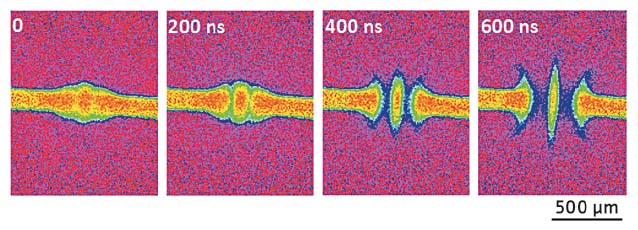 |
|
Fig. 139: A time series of X-ray radiographs during electric arc ignition of the electric fuse operation, observed with 110 ns exposure time and at 5 Mega frames per second |
Principal publication and authors
MHz frame rate hard X-ray phase-contrast imaging using synchrotron radiation, M. Olbinado et al., Optics Express 25, 13857-13871 (2017); doi: 10.1364/OE.25.013857.
Towards uncoloured environmentally friendly concrete
In the quest for environmentally friendly materials, the concrete company ECOCEM is using slag-rich concrete, mortar and other materials. These materials can display a blue/green colour when consolidated, which can be a concern in applications where visual aesthetics are important.
In order to find the origin of this colouration, scientists went to ID21 and used K-edge X-ray absorption near edge structure (XANES) spectroscopy to follow the evolution of the speciation of sulphur as the slag was hydrated (Figure 140). They found that, independently of the activating method, the blue colour was related to the presence of a pre-peak in the corresponding XANES spectrum. They linked this pre-peak to the presence of the polysulphur radical anion, S3-. This blue chromophore is known to be at the origin of the deep blue of the stone lapis lazuli or the ultramarine pigment.
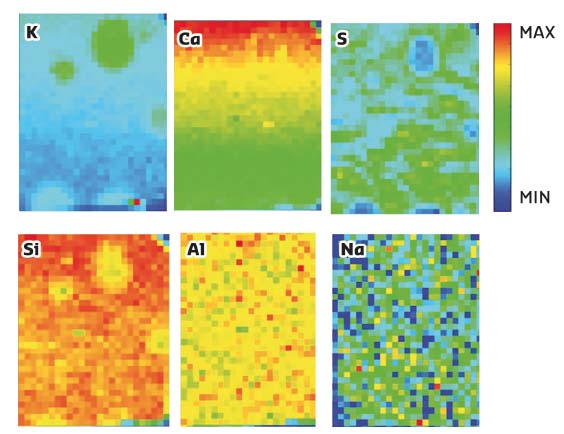 |
|
Fig. 140: Elemental distribution obtained by μ-XRF with an exciting beam of 4040 eV for K and Ca, and 2480 eV for S, Si, Al, O and Na obtained by μ-XRF with an exciting beam, map size 2.6 x 3.5 mm2 with a step of 100 µm. |
Principal publication and authors
On the origin of the blue/green color of blast-furnace slag-based materials: Sulfur K-edge XANES investigation, M. Chaouche, XX. Gao, M. Cry, M. Cotte and L. Frouin, J Am Ceram Soc (2017); doi: 10.1111/jace.14670.
Improving asthma and other respiratory diseases
Prior PLM Medical, a company supporting the medical and pharmaceutical industry to develop drug delivery devices, has been studying asthma inhalers. The efficacy of inhalers is often quite poor with only 10-20% total lung deposition for most devices on the market.
At the ESRF, they used high-speed phase contrast X-ray imaging on ID19 to visualise how the dose release event from each inhaler showed the propellant mixture behaviour inside the canister and actuator (Figure 141). In addition, mechanical interactions could be viewed taking place. This has provided new insights and is of value as a validation method for modelling efforts.
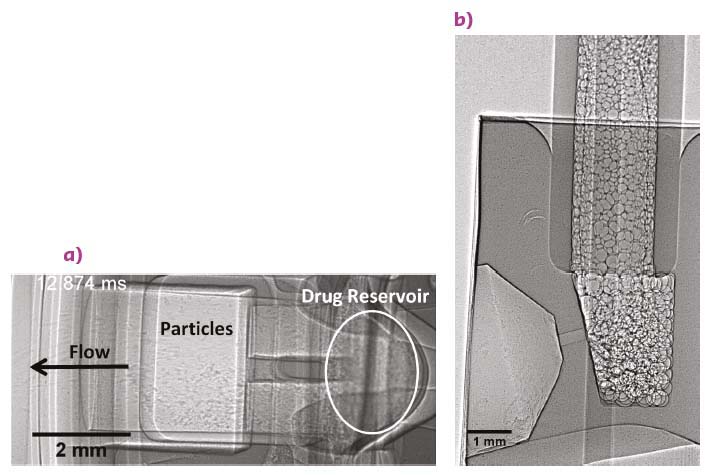 |
|
Fig. 141: a) A dry powder inhaler and b) high-speed phase contrast X-ray imaging of a dosing event in a pressurised metered dose inhaler. The video can be seen at: vimeo.com/194356596. |
Principal publication and authors
A. McKiernan, J Aerosol Med Pulm Drug Deliv 30(4):A1-A30, (2017); doi: 10.1089/jamp.2017.ab02.abstracts.
Exploring chromatographic filtering
In the global battle against cancer, the scientific community is looking into efficient solutions to effectively destroy cancer cells without harming healthy ones. A team of researchers from the University of Applied Sciences in Darmstadt (Germany), the Université de Lorraine (France) and the pharmaceutical corporation MERCK are developing new ways of separating cancerous from healthy blood cells.
They studied the technique of chromatographic filtering, which consists of flowing a cell suspension through a porous medium, which is activated by an inner surface coating. ID19 helped the scientists to delve inside the foam in an experiment reproducing the processes that take place in chromatographic filtering. The results showed that the shape of the inner surface of the foam has a considerable impact on the particle paths (Figure 142). The level of torsion of the surface is much smaller for slow cells moving close to the surface compared to that of fast cells, which underlines the importance of torsion for filter efficiency.
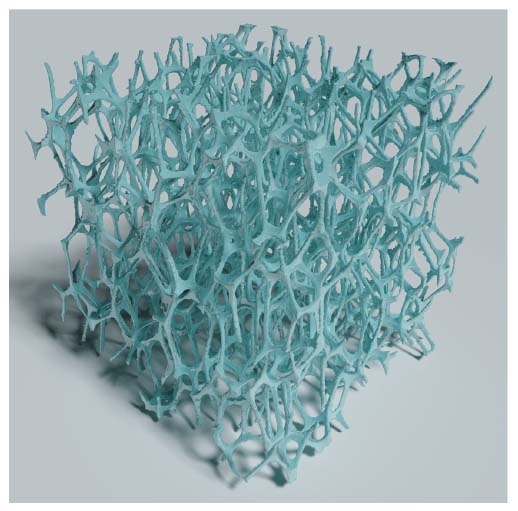 |
|
Fig. 142: Volume rendering of a tomographic data set showing a partially open foam, acquired by means of phase-contrast mathematical formula CT using synchrotron radiation. |
Principal publication and authors
Torsion estimation of particle paths through porous media observed by in situ time-resolved microtomography, C. Blankenburg et al., Journal of Microscopy 266, 141-152 (2017); doi:10.1111/jmi.12524.
Unveiling how aluminium salts in deodorants plug sweat pores using SAXS and microfluidics
Antiperspirant products use aluminium salts to decrease the amount of sweat delivered at the surface of skin. The mechanism of antiperspirants was previously thought to be a superficial plugging of eccrine sweat pores by the aluminium hydroxide gel formed in situ. Scientists from L’Oréal, LCMD (CNRS) and ESRF measured the diffusion of aluminium polycationic species in sweat counter flow using a microfluidic T-junction device. The results could open up perspectives to find new antiperspirant agents with an improved efficacy.
The device mimics sweat ducts and is designed for the real-time study of interactions between sweat and aluminium chlorohydrate under conditions that lead to plug formation. The studies were combined with small angle X-ray scattering experiments on ID02 in order to determine the structure and composition of the plug, using bovine serum albumin (BSA) as a model of sweat proteins.
The results show that pore occlusion occurs as a result of the aggregation of sweat proteins by aluminium polycations (Figure 143). Mapping of the device shows that this aggregation is initiated in the T-junction at the location where the flow of aluminium polycations joins the flow of BSA. The mechanism involves two stages: first, a nucleation stage in which aggregates of protein and polycations bind to the wall of the sweat duct and form a tenuous membrane, which extends across the junction; and secondly, a growth stage in which this membrane collects proteins that are carried by hydrodynamic flow in the sweat channel, and polycations that diffuse into this channel.
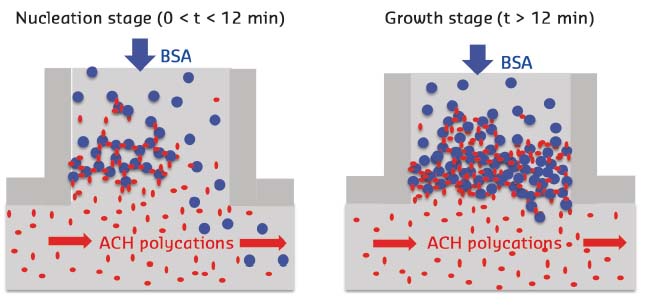 |
|
Fig. 143: A schematic, two-dimensional image of the initial membrane (left) and of a fully grown plug (right). BSA is a model of sweat proteins. |
Principal publication and authors
The mechanism of eccrine sweat pore plugging by aluminium salts using microfluidics combined with small-angle X-ray scattering, A. Bretagne et al., Soft Matter 13, 3812-3821 (2017); doi: 10.1039/c6sm02510b



